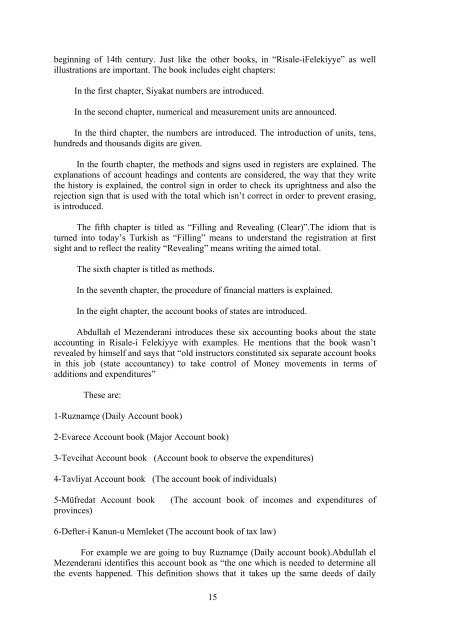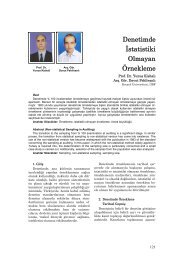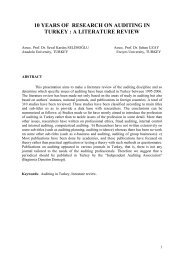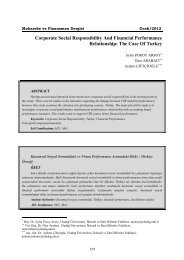an accounting system used between 14th and 19th centuries in the ...
an accounting system used between 14th and 19th centuries in the ...
an accounting system used between 14th and 19th centuries in the ...
Create successful ePaper yourself
Turn your PDF publications into a flip-book with our unique Google optimized e-Paper software.
eg<strong>in</strong>n<strong>in</strong>g of <strong>14th</strong> century. Just like <strong>the</strong> o<strong>the</strong>r books, <strong>in</strong> “Risale-iFelekiyye” as well<br />
illustrations are import<strong>an</strong>t. The book <strong>in</strong>cludes eight chapters:<br />
In <strong>the</strong> first chapter, Siyakat numbers are <strong>in</strong>troduced.<br />
In <strong>the</strong> second chapter, numerical <strong>an</strong>d measurement units are <strong>an</strong>nounced.<br />
In <strong>the</strong> third chapter, <strong>the</strong> numbers are <strong>in</strong>troduced. The <strong>in</strong>troduction of units, tens,<br />
hundreds <strong>an</strong>d thous<strong>an</strong>ds digits are given.<br />
In <strong>the</strong> fourth chapter, <strong>the</strong> methods <strong>an</strong>d signs <strong>used</strong> <strong>in</strong> registers are expla<strong>in</strong>ed. The<br />
expl<strong>an</strong>ations of account head<strong>in</strong>gs <strong>an</strong>d contents are considered, <strong>the</strong> way that <strong>the</strong>y write<br />
<strong>the</strong> history is expla<strong>in</strong>ed, <strong>the</strong> control sign <strong>in</strong> order to check its uprightness <strong>an</strong>d also <strong>the</strong><br />
rejection sign that is <strong>used</strong> with <strong>the</strong> total which isn’t correct <strong>in</strong> order to prevent eras<strong>in</strong>g,<br />
is <strong>in</strong>troduced.<br />
The fifth chapter is titled as “Fill<strong>in</strong>g <strong>an</strong>d Reveal<strong>in</strong>g (Clear)”.The idiom that is<br />
turned <strong>in</strong>to today’s Turkish as “Fill<strong>in</strong>g” me<strong>an</strong>s to underst<strong>an</strong>d <strong>the</strong> registration at first<br />
sight <strong>an</strong>d to reflect <strong>the</strong> reality “Reveal<strong>in</strong>g” me<strong>an</strong>s writ<strong>in</strong>g <strong>the</strong> aimed total.<br />
The sixth chapter is titled as methods.<br />
In <strong>the</strong> seventh chapter, <strong>the</strong> procedure of f<strong>in</strong><strong>an</strong>cial matters is expla<strong>in</strong>ed.<br />
In <strong>the</strong> eight chapter, <strong>the</strong> account books of states are <strong>in</strong>troduced.<br />
Abdullah el Mezender<strong>an</strong>i <strong>in</strong>troduces <strong>the</strong>se six <strong>account<strong>in</strong>g</strong> books about <strong>the</strong> state<br />
<strong>account<strong>in</strong>g</strong> <strong>in</strong> Risale-i Felekiyye with examples. He mentions that <strong>the</strong> book wasn’t<br />
revealed by himself <strong>an</strong>d says that “old <strong>in</strong>structors constituted six separate account books<br />
<strong>in</strong> this job (state account<strong>an</strong>cy) to take control of Money movements <strong>in</strong> terms of<br />
additions <strong>an</strong>d expenditures”<br />
These are:<br />
1-Ruznamçe (Daily Account book)<br />
2-Evarece Account book (Major Account book)<br />
3-Tevcihat Account book (Account book to observe <strong>the</strong> expenditures)<br />
4-Tavliyat Account book (The account book of <strong>in</strong>dividuals)<br />
5-Müfredat Account book<br />
prov<strong>in</strong>ces)<br />
(The account book of <strong>in</strong>comes <strong>an</strong>d expenditures of<br />
6-Defter-i K<strong>an</strong>un-u Memleket (The account book of tax law)<br />
For example we are go<strong>in</strong>g to buy Ruznamçe (Daily account book).Abdullah el<br />
Mezender<strong>an</strong>i identifies this account book as “<strong>the</strong> one which is needed to determ<strong>in</strong>e all<br />
<strong>the</strong> events happened. This def<strong>in</strong>ition shows that it takes up <strong>the</strong> same deeds of daily<br />
15

















